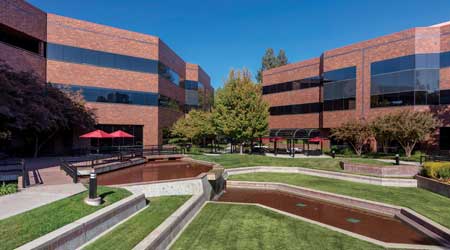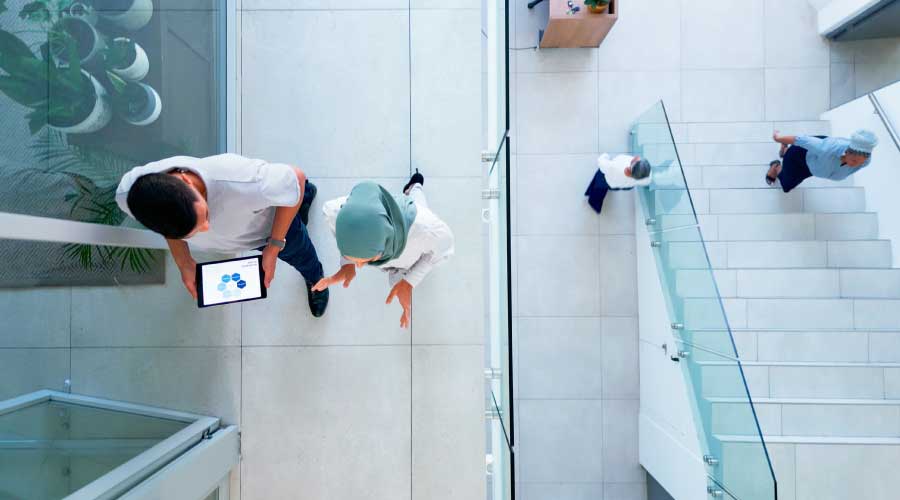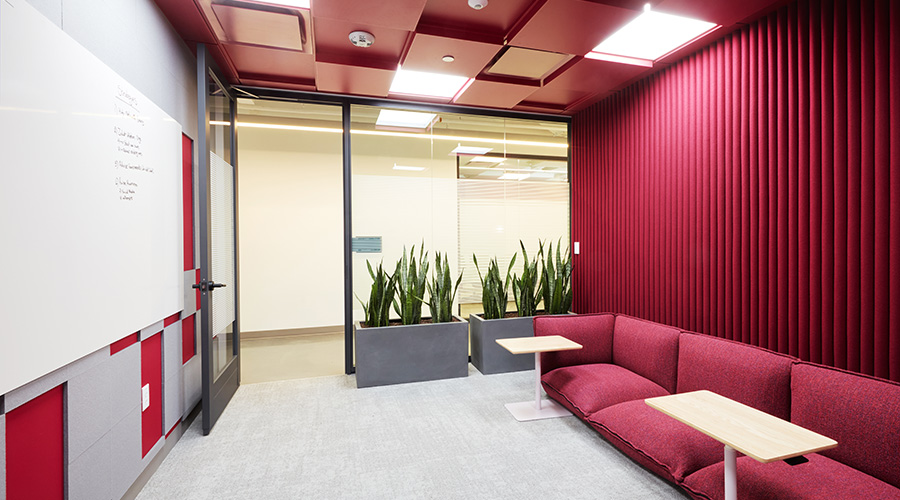 Suburban office facilities are seeing an increase in interest from potential tenants in part due to their access to outdoor space and easy parking.GPR Ventures
Suburban office facilities are seeing an increase in interest from potential tenants in part due to their access to outdoor space and easy parking.GPR VenturesCoronavirus Leaves Commercial Offices in Holding Pattern
No one has a solid grasp on the new normal for office space quite yet. But several patterns have emerged to keep occupants safe and healthy.
By Naomi Millán, Senior Editor
When Christopher Dubose, facilities manager with HSA Commercial Real Estate, used to look out of his office window at the end of the day in downtown Chicago, he would see a sea of people rushing to Union Station for their commute home. These days, he says he might see five people ambling down the empty street.
In major metros all over the country, a similar scene repeats. Many have worried, or crowed, about the end of the office. Instead, as the pandemic continues, the necessary purpose and function of commercial office space is being clarified. In the beginning of the pandemic response, many companies marveled at how well their business operations could continue with a dispersed workforce. But the grind of endless video meetings and other challenges of working remotely is starting to chafe. And some business dynamics just are not possible in a virtual environment. So organizations are considering their footprint, evaluating what exactly they need from it.
Nationwide, facility managers responsible for commercial office spaces are being forced to sit in an ambiguous moment, preparing as best they can for the inevitable, yet currently unchartable, return of their company's full workforce to the office. Certain themes are common in that experience. Here's a view on the state of commercial office, from the perspective of facility managers and property managers around the country.
No man's land
After the initial sweep of shutdowns, many local jurisdictions began easing restrictions on occupancy mid-summer. This shifted the responsibility of occupancy judgments back onto companies. Headquartered in New York City, Solomon Page, a staffing services firm with more than 65,000 square feet across 15 domestic locations, reopened its offices in early July. However, only a few dozen employees are reporting into the office on a regular basis across the portfolio, with the rest working remotely, says Ronnie Mewengkang, director of facilities. "I've done everything I can from a health and safety standpoint to create comfortable, safe places to work in, but ultimately it's the employee's individual right to decide whether or not they come in," Mewengkang says.
In Brooklyn, media company Genius evaluated their options in July and decided to keep their workforce remote until 2021, says Jason Stenbar, head of office and facilities. In addition to the company's 100,000-square-foot headquarters, there had been a satellite studio in Los Angeles. The company let go of that space recently after shifting interviews and other production to remote. Keeping their workforce remote was not just based on positivity rates in the New York City metro area, but also as an acknowledgement of the complexity company employees are currently facing in their lives. In addition, employees had dispersed to areas which had become hot spots, so forcing them back was not seen as prudent, Stenbar says.
Similarly, FHI 360 has sent everyone home and has not put a timeline on when they will be brought back into the office, says Mychal Thigpen, facility manager for the nonprofit human development organization's 300,000-square-foot Washington D.C., facility.
However, in California, GPR Ventures is seeing about a 97 percent return back into the office among its tenants, says Kristie Kuechler, senior vice president of asset management. Located in Sacramento, Kuechler says the organization is also seeing an increase of potential new tenants looking to move from their downtown locations to a suburban office facility. With typical suburban access to more outdoor space and ample parking making public transit avoidable, she says "they feel safer in a COVID world."
In the meantime
While they have been waiting for a return to full occupancy, there has been no downtime for commercial office operators. In the first wave of response, they had to drop from normal operations to becoming pandemic specialists. "It was just changing the entire way we work and how we look at our day to day," says Thigpen.
Common strategies include putting up physical dividers at reception desks or point of service areas, putting anti-microbial film on common touch points like elevator buttons, limiting occupancy in elevators, and establishing entrance protocols involving masks and temperature checks. In some buildings, the property manager went ahead and changed out faucets for touch-free models. HVAC maintenance protocols were updated, including increased air exchange rates and higher ratings on air filters. Mewengkang requested the property managers for his facilities upgrade from MERV 8 to MERV 13 filters and air exchange rates increased to six times an hour. In his facility, Stenbar was able to upgrade to MERV 10 and filter changes once a quarter, but couldn't go higher due to limitations of the existing equipment. "We upgraded filters as high as we could without losing airflow rates," adding that pushing to MERV 13 would require changing out the entire system.
Dubose added negative pressure UV fans to the elevators in some of his facilities. Operating savings from nearly vacant facilities allowed the purchase of systems upgrades. "From a financial standpoint, everything balances out because expenses for the building are a lot less," he says. "It allows you to make other purchases or improvements to the building this year."
Where building owners have outdoor spaces, steps have been taken to add capacity there to accommodate tenant needs. For example, GPR Ventures has added additional outdoor seating and built out outdoor cafe spaces so their tenants can remain operational. "Because of our climate, we can do that year round," says Kuechler.
To be determined
Significant changes to office space layout have not yet been undertaken among these facility managers. In some cases, every other cubicle has been blocked off, but more significant interior layout redesigns are being tabled for the moment. At FHI 360, plans to consolidate its footprint from two office towers to one in their D.C. facility had been made prior to the pandemic. After figuring out the logistics of packing up work stations for 200 employees working remotely and vacating the footprint while following COVID protocols, Thigpen says everything was put into storage, the new layout to be determined.
Kuechler says she is not seeing an appetite for giving back square footage among her tenants in California. "If you're trying to space people out, you're not going to shrink that floor plan," she says. However, as the pandemic wears on, some facility managers are starting to be involved in conversations around possibly letting go of floors or sub-leasing space.
What commercial office facility managers need now more than anything is clarity. "There's a lot of confusion regarding how to safely have people in the office," says Stenbar. With guidance continually changing, facility managers are holding off on making significant changes which may later be determined to be ineffectual and a waste of scant resources.
Facility managers expect certain strategies adopted during the pandemic response period to become standard protocol. Heightened cleaning and higher standards for indoor air quality are two such areas where it's hard to imagine a move backwards. "We need to continue being diligent with cleanliness and improving the air quality in all our spaces," says Mewengkang. "Clean air is a human right."
On the property management side, there is an emerging split in commercial office. Michael Feldman, chief executive officer for Choice New York Companies, a property management firm, says that large class A office, which may have already had upgraded HVAC and building automation systems, is situated better to survive the pandemic by retaining and attracting tenants. But class A is a low percentage of the overall building inventory, and most landlords won't be able to afford significant upgrades to the base building. "Your revenue is down and in order to protect it, you need to spend more money," Feldman says. "A lot of people just can't do that."
He anticipates the fallout from the pandemic in the commercial office market is just beginning, as banks cannot extend essentially free mortgages forever. "COVID is a kick in the gut," he says. "And some people won't get up from that kick."
Email comments and questions to naomi.millan@tradepress.com.
Related Topics:












